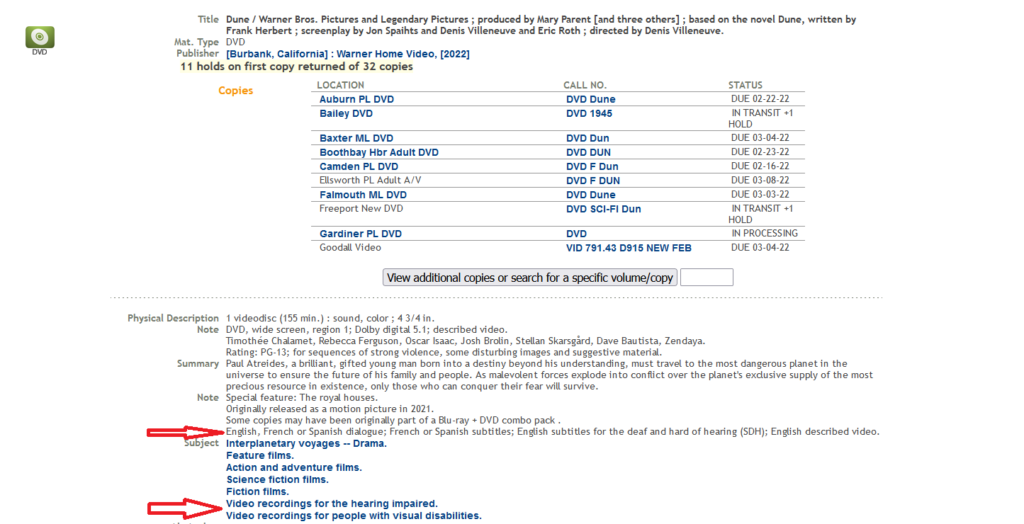We regularly have patrons looking for DVDs and Blu-rays with closed captioning or subtitles, and while it should be clearly indicated on the case, it isn’t always so easy to tell exactly which service is available. Looking them up in our library catalogue is another way to tell. It should list the features in the note and subject sections. See the screenshot below as an example:

While closed captioning and subtitles are similar, there are differences in intended purpose as well as features. In looking further into it, we have learned a few things that we’d like to share.
Closed Captioning versus Subtitles
Closed Captioning (CC)
Closed captioning (CC) was developed to help ensure accessibility for individuals that are deaf or hard of hearing. Closed captions involve transcriptions of dialog – the conversion of audio into text form in the exact wording that the original speaker used. They also communicate other audio such as sound effects, speaker IDs, and non-speech elements. “Closed captions should account for any sound that is not visually apparent but is integral to the plot. For example, the sound of keys jangling should be included in closed captions if it is important to the plot development – like in the case where a person is standing behind a locked door.” source

Subtitles
Intended for viewers who can hear but do not speak/understand the language used in a video, subtitles are translations – an interpretation to convey meaning, not exact wording – of video dialogue into other languages so that audiences all over the world can watch videos, movies, and more in their native language (or language of choice). They communicate spoken content only, not non-speech elements such as sound effects, and are synchronized to media files so that they play at the same time as the spoken word.

Now that we have touched on the differences between CC and subtitles, let’s look at a couple of other accessibility options…
Subtitles for the Deaf and Hard of Hearing
Subtitles for the Deaf and Hard of Hearing (SDH, SDHH) are written for viewers who may not be able to hear the audio and combine the information of both captions and subtitles. SDH contains information about background sounds and speaker changes, along with a translation of the script.
How is it different from closed captioning?
– The biggest difference is that the two are encoded differently and closed captioning is not supported by High Definition Media Interface (HDMI), while regular subtitles and SDH are. Therefore, SDH can be found on many more types of media such as streaming internet videos and Blu-ray DVDs.
– There is also a difference in appearance. Traditionally, closed captions have been formatted as white text on a black background that can be positioned anywhere on the screen. In contrast, SDH is usually text overlaid directly on the video and is found on the bottom third of the screen and can vary in color.
Remember we just said that closed captions are not supported by HDMI? If you are trying to access this feature on a DVD that says it has “CC” but can’t seem to make it work, this is why – the signal is in an older format which is incompatible with today’s technology. SDH has been replacing closed captioning on newer DVDs due to the easier access. If you don’t see the “CC” symbol, look for the SDH abbreviation.

Descriptive Audio
Descriptive audio enables individuals who are blind or have low vision to hear a spoken narration of a movie’s key visual elements including actions, settings, facial expressions, costumes, and scene details & changes. Descriptive audio supplements the regular audio track of a program and is usually added during existing pauses in dialogue.
Here is a short example from Lion King that will give you a clear sense of what this service offers.
This feature goes by many labels including English descriptive audio (the most common), English described audio, audio described English, video description, described video… you get the point.
The Audio Descriptive Project is a very thorough online resource about this service and maintains a list of DVDs with audio description.

We hope you have found this information helpful. Please do let us know if you have any questions.
